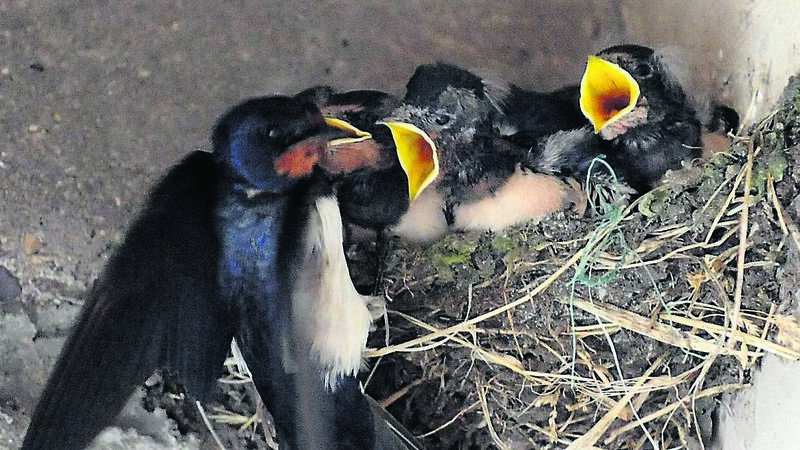I saw the first swallows, hope it means warmer days ahead!

No matter who sang the words, it strangely came ringing in my ears on Tuesday night last. I know it’s strange, but random happenings can twig random thoughts in my brainbox.
On a chilly March-like mid-April evening, I was out for a short walk just as the daylight was fast fading. With a plethora of coloured weather warnings in vogue, I felt sorry for the four swallows I saw twittering around the high gable of a dwelling house where at least one nest had been ‘erected’ in recent years.
Of a normal year, the arrival of the swallows would be a certain portent of good weather on the way - not so sure this week though.
There’s a story told that swallows were nesting in the eaves of shops and houses in San Juan Capistrano in California. Regarded as a nuisance and with constant droppings falling, they weren’t exactly the most beloved of callers.
Legend has it that a priest ‘invited’ the little birds to come and stay at a nearby Mission Church, and apparently ever since they return to Capistrano around mid-March annually.
The year World War II started, 1939, Kentucky-born songwriter Leon Rene wrote the song about the swallows coming back after he heard it mentioned on the wireless. Nowadays the sight of the returning birds is a kind of tourist attraction in that part of California. They say that swallows keep coming back to the very same nest year after year.
Now, the average lifespan of a swallow is just two years - occasionally three - but generations of the same ‘family’ return to the spot where they and their feathered ‘ancestors’ first saw the light of day.
They are expert nest-builders and superb ‘plasterers’ as they repeatedly repair and patch up old nests with muck and mud. In fairness, you’d never describe the external appearance of a swallow nest as pretty or beautiful. No, they are simply functional, but internally they are exquisite with animal hair and fur combined to form a perfect place for the eggs to hatch out.
Not sure why they came here - was it a nice temperate climate? Were they fleeing excesses of heat and/or cold - all these questions remain unanswered in my head all these years later.
I suppose as a child ‘ours was not to reason why’ - we just accepted things as being normal. Like cold, frosty weather from November to February. Then spring followed, new growth, fields greening up as the days lengthened. When summer came it really came and those lazy, crazy days were really just that.
Am I looking back through 60 years of ‘rose-tinted glasses’, the memories of how we remember what the weather was like in the early 1960s? Maybe the memory plays tricks on us, convincing us that the long, hot summers were a reality rather than a hazy, shimmering mirage!
It was Nat King Cole sang Those Lazy, Hazy, Crazy Days Of Summer with the line ‘You wish that summer could always be here’ - in truth, a week like we’re having at present does make one yearn for a bit of heat.
I was surprised to see that quartet of swallows at dusk on Tuesday. Long ago we were told by our elders that the first handful to come were kind of ‘scouts’ - that they basically came - like the President’s Security men - to suss out the lie of the land. Maybe they came to check out the temperature and the way things were growing in the Emerald Isle of Ireland.
Swallows consume vast quantities of insects. Insects mainly live on plants and flowers. If the growing season isn’t well under way when the swallows arrive and the insect life is scarce, food sources would present a major problem.
If the lads on Tuesday were checking out the conditions for the main body of swallow tourists to come, how do they get the positive or negative message back across the oceans - giving the green ‘Yes, come on, light’ or the red ‘Stay where ye are’ message?
Aw lads, truly nature is amazing and I never cease to ponder on it and still I haven’t the answers - some things are mysteries and destined always to remain so.
It was my grandfather that bought the old National School building nearly 120 years ago when the ‘New School’ was built. He brought it down here and stone by stone, slate by slate he built a cow-stall. With fine rafters, high eaves and plenty nooks and crannies, it was paradise in itself for the wandering swallows and they quickly colonised the building.
I know down the years many a person milking a cow whilst sitting on a three-legged stool might let a string of curses heavenwards after a swallow deposited droppings on an unsuspecting head under the rafters! Despite this, we never considered trying to keep the swallows out -aren’t they as entitled to their place on life’s ladder as we are?
Then, when the swallow chicks arrive the parents were in out, in, out darting here, there and yon to keep a constant food supply in front of their hungry brood. They always remind me of penguins or waiters with their creamy white breasts and sleek feathers and intelligent eyes.
Lack of biodiversity, of course, is a threat to the swallows’ future in this country. Let’s hope that in years to come we won’t be recalling and telling generations yet unborn about swallows - in much the same manner as older people tell me of the corncrake, the partridge and the owls.
As ditches and hedges are removed to increase field size trees, bushes, shrubs and wild flowers disappear.
President Joe Biden is here these days from the USA. One of his predecessors in the White House, John F. Kennedy used often quote JK Chesterton: “Don’t ever take a fence down until you know why it was put up” - how true that is. It applies not alone to physical features but to all life-changing matters.
So-called progress is often the destroyer of tradition - for no good reason, just change for the sake of change. The swallows have been coming here forever so let’s hope they continue to come and bring true summer with them - like long ago.
They say the swallows in Capistrano leave each year for winterage in Argentina around October 23, the Feast of San Juan. Their comings and goings to Ireland aren’t tied to any calendar date but we hope, as these wicked, windy days depart over the horizon, the twittering birds will come again. Their feathered forbearers never missed a summer yet.
Ah yes, there’s a grand stretch in the evenings now. The clash of the ash is to be heard once more across the country. Once the swallows are back we’ll all have a pep in our step again. Anois teacht an fáinleog beidh an samhradh againn.







 App?
App?




